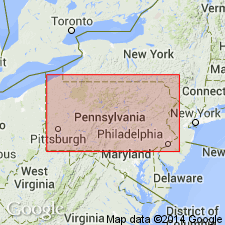
- Usage in publication:
-
- French Creek limestone member
- Modifications:
-
- Original reference
- Dominant lithology:
-
- Limestone
- AAPG geologic province:
-
- Appalachian basin
Summary:
(June 9, 1934). Pg. 135-136. [French Creek limestone member of Cuyahoga formation.] It is here proposed that upper Meadville limestone be known as French Creek limestone, from outcrops in ravines eroded by tributaries to French Creek, Crawford County, northwestern Pennsylvania. Type section is ravine at "Glendale" Cemetery, in Meadville city, [approx. Lat. 41 deg. 38 min. 45 sec. N., Long. 80 deg. 08 min. W.]. Thickness 1 to 2 feet. Age is Mississippian.
In early part of this report this limestone was called Conneaut limestone, but Conneaut is withdrawn as name for the limestone, at request of G.H. Chadwick, who desires to apply "Conneaut" to a different unit in same region. [Table opp. p. 61 shows this limestone as overlain by Custards shale member (=upper Meadville shale of early reports) and underlain by Harvest Home shale member, all included in his Meadville stage (Meadville monothem).]
[GNC remark (April 2, 2012): No references in GNC index card files to indicate usage since its introduction. Name is considered abandoned; rocks included in Meadville Shale Member of Cuyahoga. See Meadville.]
Source: US geologic names lexicon (USGS Bull. 896, p. 779-780).
For more information, please contact Nancy Stamm, Geologic Names Committee Secretary.
Asterisk (*) indicates published by U.S. Geological Survey authors.
"No current usage" (†) implies that a name has been abandoned or has fallen into disuse. Former usage and, if known, replacement name given in parentheses ( ).
Slash (/) indicates name conflicts with nomenclatural guidelines (CSN, 1933; ACSN, 1961, 1970; NACSN, 1983, 2005, 2021). May be explained within brackets ([ ]).

